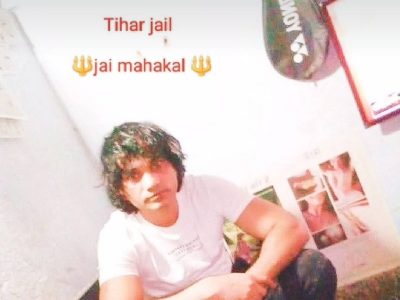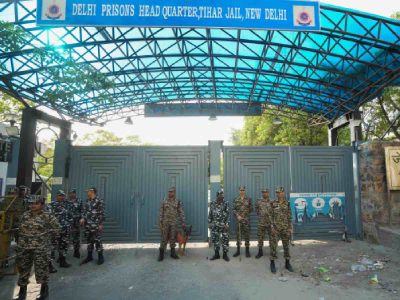A shaky camera paired with a blurry view of a courtyard plays over a catchy Haryanvi song — that’s the opening of an Instagram reel uploaded on March 21. But beyond the visual haze, one element stands out starkly: a caption reading Tihar Jail Delhi.
What was once left to the imagination or confined to crime dramas has now surfaced as an eerie slice of reality. The gun-toting image of Bachan Rana, a self-proclaimed ‘badmash’, serves as a chilling reminder of how rules can be flouted with alarming ease inside the infamous Tihar Central Jail in Delhi.
Several reels were posted by Instagram user @bachansohatiya in March and April. His profile projects a flamboyant lifestyle: laughter, drinks, and camaraderie with friends. Yet among these are multiple posts purportedly from inside the prison — not just of the courtyard, but of the ward itself. According to Rana, he has been out of jail for two years. Still, these visuals, apparently captured while he was an inmate, have found their way into the public domain.
Phones, drugs, and pan masala: A long list of banned items
Possession of mobile phones in jail is a clear violation of prison regulations, which prohibit a range of items including spirituous liquors, ganja, bhang, opium, smack, explosives, dangerous drugs or poisonous substances; all arms, ammunition, weapons, and any object that could be used as a weapon; valuables such as jewellery, currency, and securities; unauthorised printed materials and appliances; and makeshift tools like rope, bamboo, bricks, or sticks.

The list further includes electronic gadgets like wireless devices, tape recorders, and typewriters; gambling implements like playing cards; tobacco and pan masala; certain types of sports shoes; and even items like polythene bags, fruits, non-vegetarian food, and curried vegetables. Any other unissued or unpermitted item may be prohibited at the discretion of the Jail Superintendent or their deputy.
While smuggling phones into jails is not new, the shock lies in how brazenly the content has been shared online. Corruption within prison walls is a known concern, but rarely do such visuals emerge — particularly those apparently shot by the inmates themselves.
Also Read: Overcrowded and affected by substance abuse: Issues ailing Delhi’s juvenile care institutions
Several photos on Rana’s account show him interacting casually with other inmates — chatting, playing cards, or simply lounging. In one frame, a badminton racket hangs on the wall behind a row of beds covered with standard bedsheets — the scene oddly domestic, even comfortable.
An outdated system in a 5G world
The presence of a phone inside the premises also suggests the possibility of calls being made from within. Currently, Tihar Jail has 15 mobile jammers installed across six additional locations to block signals. These complement three Towers of Harmonious Call Blocking systems, which are designed to terminate calls as soon as they are initiated. However, all of these systems are limited to blocking 2G, 3G, and 4G networks — rendering them ineffective in the 5G era.
View this post on Instagram
The outdated jamming infrastructure raises concerns about the extent of surveillance over inmates. The fact that a prisoner could smuggle in a phone — and use it to record and upload videos — underscores major loopholes in Asia’s largest jail.
According to Rana, smuggling in a phone costs around Rs 1.5 lakh. “Ek do lakh me sab mil jata hai Tihar me (You can get whatever you want within Rs 2 lakh at Tihar),” he commented on one of his posts.
A prison official, speaking to Patriot on condition of anonymity, confirmed that Rana was an inmate around 2021 and that the visuals are believed to be from that period. “We cannot hold anyone accountable at the moment because there have been multiple reshuffles following his indictment,” the official said.
Chilling backdrop of gang violence and overcrowding in Tihar
According to officials, monitoring prisoners using mobile phones has proved increasingly difficult due to the presence of notorious gangsters inside Tihar Jail. To put matters into perspective, Jails 8 and 9 are housed in the same building—the only double-storeyed structure in the prison complex. It was in this very building that two infamous gangsters were murdered within a week of each other in April 2023.

During this period, gangster Tillu Tajpuriya was allegedly stabbed to death by four rival inmates inside his cell—just weeks after Prince Tewatia, an aide of Lawrence Bishnoi, was killed in a similar manner.
Four individuals reportedly descended from the first floor of the ward and attacked Tajpuriya using improvised weapons. The Delhi Police Special Cell has since booked six inmates on charges of murder and criminal conspiracy. Meanwhile, the Delhi Prisons Department has suspended eight jail officials, and the Tamil Nadu Special Police has recalled seven of its personnel for negligence in duty.
View this post on Instagram
At present, sources estimate that approximately 13,029 prisoners are lodged in the Tihar complex, which has a sanctioned capacity of only 5,200. This reflects an overcrowding rate of over 250%, creating significant challenges for prison authorities. Despite daily checks, officials are also expected to ensure that prisoners maintain discipline and order within the premises.
“There is some usage of cell phones, but we are conducting almost daily surveys to check if any such prohibited items are found within the jail premises. At the same time, we must understand what mechanisms help maintain discipline among inmates, so they do not cause disturbances,” said an official, speaking on condition of anonymity.
View this post on Instagram
However, in light of Rana’s alleged revelation, critics argue that such claims are merely a cover-up for the rampant corruption plaguing the central jail complex.
In response to the growing concerns, the jail authorities established an Intelligence Cell on March 6 to covertly monitor the possible supply of weapons, drugs, and communication devices inside the facility. Among the most frequently seized items are Kechaoda phones — compact devices known for their excellent sound quality and signal reception, making them especially hard to detect.
The new Intelligence Cell is headed by a superintendent-level officer and a deputy superintendent, with several jail staff deployed to support covert surveillance operations.





